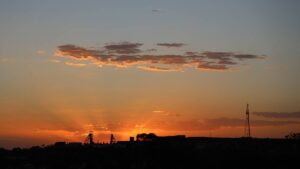Tim Treadgold: Aurelia is more than a one-hole wonder

Pic: Tyler Stableford / Stone via Getty Images
Aurelia Metals (ASX:AMI) hit the headlines late last month after reporting a spectacular gold assay but the company is more than a gold explorer, it is emerging as a true mid-tier producer of a range of metals — with dividend payments to boot.
The assay which excited everyone, including Stockhead (Gold: Aurelia stuns with sky-high gold assays in NSW), was from a 1m-wide intersection grading 1160 grams a tonne (g/t), equivalent to more than 37.5 ounces to the tonne in the old language.
Stunning as the drill result might have been, it was narrow, and even though it was the core of a wider 6m zone assaying bonanza-grade 196g/t it has not left much of a mark on Aurelia’s share price.
After a short-term bump which added 5c to the stock, it is now below where it started at around 44c.
One reason for the slide is that the gold price has been in retreat, dropping from $US1,510 ($2,206) an ounce on the day Aurelia reported its big hit from drilling into the Kairos lode under the historic Peak mine near Cobar in western NSW to around $US1456/oz today.
Gold, however, is not the only share-price driver in Aurelia.
A handy cocktail of base metals
It is also a producer of copper, lead and zinc, a handy cocktail of base metals which expose the company to industrial demand which might be flat today but could pick up next year if there is a meaningful truce in the China v US trade war.
The best way to see Aurelia is as a well-balanced mid-tier miner with two operating mines in a region with proven mineral fields, a useful mix of commodities, a modest dividend of 2c a share last year, and a promising exploration program that is expanding the development potential footprint.
On the production side of the business there are the Peak and Hera mines, about 100km apart with Peak close to Cobar and Hera close to Nymagee.
Peak has a production history dating back to 1992, with the last owner before Aurelia acquired it in 2018 being Canadian company New Gold.
Hera was acquired as an undeveloped gold-lead-zinc-silver prospect from CBH Resources in 2009 with commercial production starting in 2015.
In the latest quarter to September 30, Aurelia was more of a gold miner than a base metals producer, with Peak yielding 18,772 ounces of gold at an all-in cost of $764/oz, while Hera yielded 10,535/oz at $1,149/oz – with a useful contribution of lead and zinc from Hera and copper, lead and zinc from Peak.
The current (December) quarter is not expected to be as good, which could be another reason for the share price contraction, because plant upgrade work at Peak, and also because of the potential for a water shortage as drought bites in western NSW.
For the full year ahead, gold production at Peak is expected to be less than last year, while at Hera there is expected to be an increase in base metals as mining moves into areas richer in lead and zinc.
But the real interest in Aurelia is not so much the established business but the way in which cash flow from existing production is funding an expanded exploration program which is, in turn, starting to yield excellent results that should add years to mine life.
At Peak there are the high-gold grades being encountered in the Kairos lode, which was only discovered earlier this year, while work is also underway on an upgrade to the lead and zinc circuit.
At Hera there is exploration underway at the North Pod, a mineralised structure that will extend the life of the mine, while a new discovery called Federation, located about 10km south-west of the mine, is showing promise with recent assays that include 26m at 16.4 per cent combined lead and zinc, plus emerging gold potential.
Breaking out the fresh buy tips
Not a widely-researched company, Aurelia also has a low media profile. The top item in the “media” section of its website is about winning an award at the Diggers & Dealers forum in Kalgoorlie in 2014! The second item is a 2012 story from The Australian newspaper.
But last week some of the cobwebs were blown away when analysts from Macquarie Bank visited Peak and Hera largely to check out the exploration programs at both mines.
The result of the bank’s visit was a refreshed buy tip with a share price target over the next 12-months of 65c which, if delivered, represents a potential gain of 47 per cent.
The only problem with Macquarie’s price tip is that the bank has been maintaining a buy on Aurelia all year and as recently as April the price forecast was $1.
Setting aside the premature optimism, there is a strong case underpinning Macquarie’s repeated buy tip and that’s in the potential for an expanded exploration budget, funded by mine cash flow, delivering meaningful discoveries.
“Aurelia’s exploration spend has previously been constrained by limited cash flow,” the bank said.
“In the 2019 financial year, $7m in exploration spending yielded highly prospective discoveries which have the potential for meaningful mine life extensions.
“Importantly, the success is in close proximity to established infrastructure, with Federation 10km from Hera while Kairos lies directly beneath the underground crushing and hoisting infrastructure at Peak.
“With a $15m spend in the (current) 2020 financial year we expect positive results to continue while the process upgrade at Peak will give Aurelia greater flexibility to exploit potential resource additions.”
Read more from Tim Treadgold:
Unloved OceanaGold could be the ‘worst house in the best street’
OreCorp is clearing hurdles in Tanzania and its share price has doubled
Rare earths could be another ‘buy the sector’ situation, just like nickel
UNLOCK INSIGHTS
Discover the untold stories of emerging ASX stocks.
Daily news and expert analysis, it's free to subscribe.
By proceeding, you confirm you understand that we handle personal information in accordance with our Privacy Policy.








